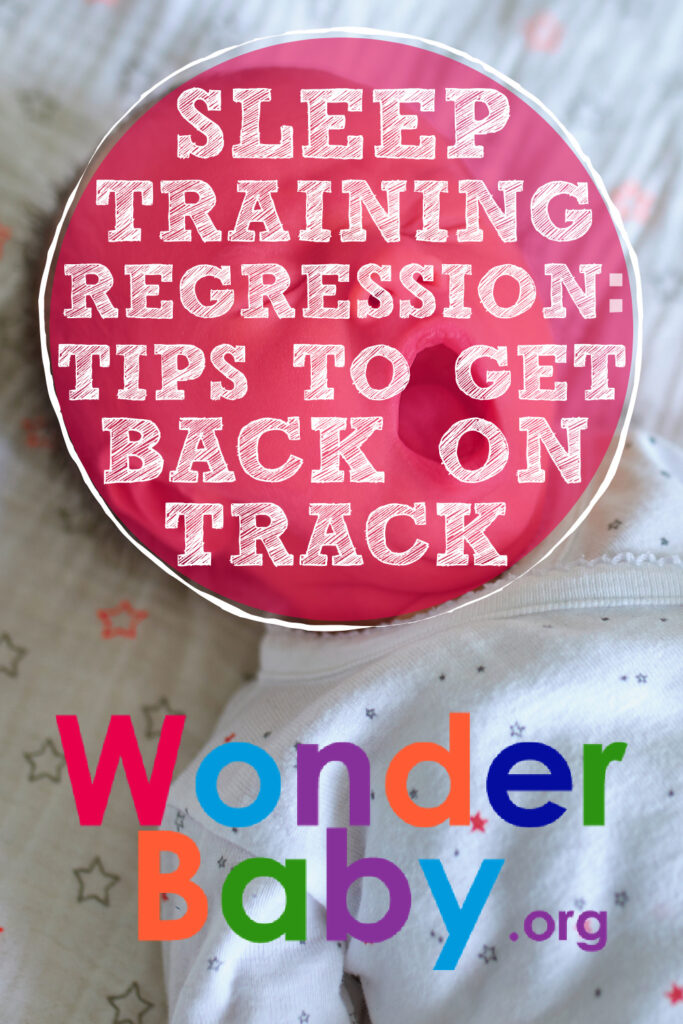Sleep Training Regression: 7 Tips To Get Back on Track

- Baby sleep regressions happen when a child who has been sleeping well through the night suddenly has a period of disrupted or disturbed sleep.
- Sleep problems can still happen despite your efforts to sleep train your baby.
- Sleep regressions are common and are often the result of physical and developmental changes.
- Consistency, patience, and routine will help you teach your baby to fall asleep and stay asleep independently.
The first time your baby sleeps through the night can feel like a miracle. After months of sleep deprivation, you, your baby, and your whole family might feel like different people when you get up in the morning.
You pat yourselves on the back for finally cracking your broken nights. All that work on sleep training actually paid off!
Then suddenly, just like that, the crying, fussing, and waking every two hours start up again, and you can’t figure out why. It might be a sleep regression, a common sleep problem that can affect even sleep trained babies.
The good news is that a sleep regression will pass, like many other phases your baby will go through as they grow and change.
We’ve rounded up the best tips on how to get back on track when you’ve hit a sleep training regression to help you and your baby get back to sleeping soundly soon.
What Is a Sleep Training Regression?

Sleep regression generally describes a change in your baby’s sleep pattern. A baby who slept for longer, undisturbed periods may suddenly switch to shorter, irregular periods of disrupted sleep, known as a regression.
For example, if your baby generally slept through the night but has returned to waking every two to three hours, they may be experiencing a sleep regression.
All babies can have periods of sleep disruption and changes in their sleeping patterns for various reasons. Many kids will experience sleep regressions. Others may not.
Even babies who have been sleep trained can experience periods of sleep regression which can be discouraging—and tiring—for parents.
Does a regression mean that all your hard work on sleep training was for nothing? Not at all. These periods of disrupted sleep will pass, and with a little help, you can get your baby back on track.
What Causes a Sleep Training Regression?

There can be many reasons for sleep regression. Sleep regression often happens in the first two years of your baby’s life.
Many babies experience their first regression around four months old11. Understanding and Navigating Sleep Regressions. Lancastergeneralhealth.org. https://www.lancastergeneralhealth.org/health-hub-home/motherhood/the-first-year/understanding-and-navigating-sleep-regressions, when they develop their circadian rhythm and their body triggers new sleep cycles.
There may be multiple causes of sleep regression for older babies and toddlers, even those who have been sleep trained, including:
- Brain development.
- Growth spurts.
- Reaching milestones like crawling or walking.
- Sleep disruption due to teething.
- Illness.
- Changes in routine.
- Sleeping in a new place—for example, on vacation.
- Separation anxiety.
How to Tell if Your Baby Is Experiencing Sleep Training Regression

The first sign of sleep regression is a disruption in your baby’s usual sleeping pattern. If your baby goes from sleeping through the night to waking frequently, this may signal a regression.
Other signs of sleep regression22. Cleveland Clinic. Infant sleep regression: What parents need to know. Cleveland Clinic. 2022. https://health.clevelandclinic.org/the-4-month-sleep-regression-what-parents-need-to-know include:
- Increased fussiness.
- Changes in daytime sleep, including dropping a nap.
- Having a hard time falling asleep.
- Increased crying at bedtime.
If you notice these signals, it’s important to rule out other issues first, like illness, before assuming your baby has entered a period of regression.
These signs could also indicate your baby is hungry, in pain, or unwell. However, consider whether sleep regression is the issue if you see these signals over a stretch of days and nights.
Should You Let a Sleep Trained Baby Cry It Out During a Regression?

It can be frustrating for parents and babies when months of peaceful nights suddenly revert to what may feel like the newborn days of around-the-clock waking.
It’s especially hard if you put a lot of time into sleep training and now find that your carefully built routine no longer works.
So should you just let your baby cry it out if they’re going through a regression?
First, consider the age of your baby. If your baby is under six months old, they will still be experiencing changes in their sleep cycle and sleep training of any kind is not likely to be effective.
Night wakings are common and perfectly normal for babies of this age.
Crying It Out
If your baby is old enough, the cry it out (CIO) sleep training method suggests that parents follow a bedtime routine and then put their baby down awake in their crib, leaving them to cry for as long as necessary until they fall asleep without tending to them.
Proponents of this method believe it is the quickest way to teach a baby to self soothe and get to sleep on their own. If your baby wakes in the middle of the night, the idea is to let them cry it out until they go back to sleep.
If your baby is having a sleep training regression, some parents think this method is the most effective way to help them learn to get back to sleeping through the night.
Graduated Extinction
Many parents, though, find crying it out to be too harsh and can’t follow through with it. Critics are also concerned that parents could miss signs of illness when they don’t respond to their baby’s cries.
The American Academy of Pediatrics33. Getting Your Baby to Sleep. HealthyChildren.org. 2022. https://www.healthychildren.org/English/ages-stages/baby/sleep/Pages/getting-your-baby-to-sleep.aspx recommends a gentler variation of CIO known as graduated extinction.
This method also involves establishing a bedtime routine and putting your baby down awake so they learn to self soothe and fall asleep on their own without rocking or feeding.
However, if your baby is crying, you respond to them. The idea is to lengthen the time between your responses to your child’s cries. In this way, they gradually become an independent sleeper.
Your baby knows you are there if they need you, but they are not dependent on your physical presence to help them fall asleep.
Sleep Training, Again
You may have already sleep trained your baby using the chair method, fading, gentle sleep training, CIO, or another method.
The good news is, if your child becomes a great sleeper once, they can do it again. According to Katharine Gammon of The New York Times, one of the greatest misconceptions about sleep training44. Gammon, K.. What to do if your sleep-trained baby stops sleeping. The New York Times. 2020. https://www.nytimes.com/article/sleep-training-regression.html is that most children and parents only go through it once.
As children grow and change, their sleep will also change. Other events, like illness, travel, and teething, will intervene and may disrupt sleep, just like it does for adults.
When this happens, it’s important to stay consistent, be patient, and use what worked for you before, and in no time, you’ll help your baby to sleep soundly again.
How to Handle a Sleep Training Regression and Get Back on Track

It may not feel like it when you’re up in the middle of the night with a crying baby, but sleep regressions won’t last forever. These periods will pass.
There are a few things you can do, though, to help yourself and your baby during a sleep regression and to establish good sleep habits overall.
Stick to the Bedtime Routine
Even if your baby is currently having trouble falling asleep or not sleeping well now, maintaining a consistent bedtime routine will help everyone’s sleep in the long term.
Try to start your routine at the same time every night. You might do something like bath, story, bottle or breast, bedtime.
To teach your baby to self soothe and get to sleep on their own, put your baby down to sleep when they’re drowsy but still awake.
If they fall asleep while feeding or rocking in your lap, they will have a much harder time getting back to sleep on their own when they wake up in the middle of the night.
Keep Your Routine, Wherever You Are
Although it can be challenging, try to maintain your nap and bedtime routines as much as possible.
Baby sleep regressions are often triggered by travel, sleeping in new places, and meeting new people.
On the weekends and when you’re traveling or on vacation, try to maintain your day and nighttime sleep routines as well as you can.
Eating Enough During the Day
Growth spurts or developmental changes might mean your baby is actually feeling hungry at night, contributing to their disrupted sleep.
Make sure your child has eaten enough during the day. A light snack before you start your bedtime routine might be a good idea if your child wants one.
Practice with Naps
Learning to self-soothe and get back to sleep is a life skill that many children need to be taught. Help your baby practice this by putting them down for their daytime naps while they’re still awake.
By encouraging them to get to sleep independently at nap time, you’re helping them understand how to do this at bedtime and in the middle of the night too.
Create a Sleep Environment
A calm atmosphere at bedtime is essential for encouraging sleep. An overstimulated baby will experience sensory overload and have trouble sleeping.
Make sure the sleeping environment is calm room, cool, and dark or semi-dark, with minimal noise, distractions, sounds, or lights.
Avoid screen time, exciting games, and exercise before bed. Calm, soft music, stories, and quiet activities should be part of your bedtime routine instead.
Stay Consistent
If your child is waking up in the middle of the night, it might be tempting to rock, feed, or nurse them to get them back to sleep as quickly as possible.
Of course, if your child is waking up because they’re uncomfortable, have teething pain, are unwell, or are genuinely hungry in the middle of the night, you should address those issues.
However, if your child is waking up at night and having trouble getting back to sleep, you should respond to them as you do at bedtime.
You want to avoid creating new sleep associations, like, “If I wake up in the middle of the night, I’ll get cuddled and rocked back to sleep.”
Experts from Penn Medicine recommend calming your baby without picking them up or rocking them so they learn to fall back asleep on their own and sleep independently.
Nap Schedule Reboot
Another American Academy of Pediatrics recommendation is to “make daytime playtime.” This means encouraging your baby to stay awake longer during the day so that they sleep longer at night.
As babies get older, they need fewer naps and less daytime sleep. Your child might be ready to drop to one nap or may need short naps rather than a long daytime sleep.
Be aware, however, that overtired babies can also have trouble getting to sleep and staying asleep at night. So look for signs your baby is ready to drop naps before you encourage it.
When To Get Help
Before you start sleep training, talk to your pediatrician about whether it’s appropriate for your child. Your child should be between four and six months before you try a sleep training program.
Also, if your baby has any health conditions or special needs, it is very important that you speak with your doctor before trying a sleep training method.
You should also rule out illness before assuming that early waking or night waking is a sleep regression. If there is a sudden difference in your child’s sleep or eating behavior and your interventions aren’t helping, you should see your doctor.
Finally, according to the American Academy of Cardiovascular Sleep Medicine55. Floro, B.. Let them cry it out? pediatric sleep hygiene. AACSM. 2020. https://aacsm.org/let-them-cry-it-out-pediatric-sleep-hygiene/#:~:text=One%20study%20by%20the%20American,going%20in%20to%20soothe%20them., there are some pediatric sleep disorders your doctor can investigate with you, such as sleep apnea, if your child’s sleep is still disturbed, despite your best efforts.
References
- Understanding and Navigating Sleep Regressions. Lancastergeneralhealth.org. (n.d.). https://www.lancastergeneralhealth.org/health-hub-home/motherhood/the-first-year/understanding-and-navigating-sleep-regressions
- Cleveland Clinic. (2022, June 13). Infant sleep regression: What parents need to know. Cleveland Clinic. https://health.clevelandclinic.org/the-4-month-sleep-regression-what-parents-need-to-know
- Getting Your Baby to Sleep. HealthyChildren.org. (2022, August 30). https://www.healthychildren.org/English/ages-stages/baby/sleep/Pages/getting-your-baby-to-sleep.aspx
- Gammon, K. (2020, April 17). What to do if your sleep-trained baby stops sleeping. The New York Times. https://www.nytimes.com/article/sleep-training-regression.html
- Floro, B. (2020, August 27). Let them cry it out? pediatric sleep hygiene. AACSM. https://aacsm.org/let-them-cry-it-out-pediatric-sleep-hygiene/#:~:text=One%20study%20by%20the%20American,going%20in%20to%20soothe%20them.

Related Posts

Sleep, Special Needs
Safe Place Bedding Travel Bed Review
Traveling with a special needs child can be stressful! Having a safe, durable, and easy to use travel bed can make traveling so much easier!

Sleep, Special Needs
Sleep Regimen for Premature Babies: Special Considerations
It can take premature babies much longer than their full-term peers to sleep for long stretches. A preemie sleep schedule may encourage better sleep.

Sleep
Mastering the Bedtime Routine: 3 Tips for a Peaceful Night’s Sleep
From around six weeks, a newborn bedtime routine can help your baby learn the difference between day and night and prepare for a restful night’s sleep.